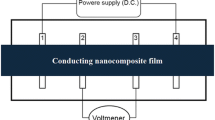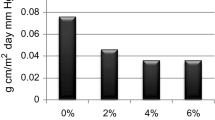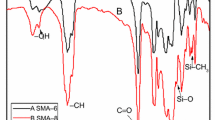Abstract
In this paper, poly(styrene-acrylate) latex with phosphate functional group (SA-PO) was prepared using mini-emulsion polymerization. Polyaniline (PANI) bonded SA (PANI-SA) composite was then prepared by in situ chemical oxidation polymerization of aniline. FT-IR and UV–Vis spectra confirm the formation of the PANI-SA composite. Small spherical particles of 10–20 nm in diameter on the surface of SA latexes are observed by SEM. DSC and TGA results indicate that there are chemical bonds formed between PANI and SA, and PANI in the PANI-SA composite can increase the glass transition temperature (T g) and thermal decomposition temperature (T d) of SA latex film effectively. Mechanical property testing indicates that PANI in PANI-SA composite can increase the mechanical properties of SA latex film. EIS measurements show that PANI in SA-PANI can significantly improve the corrosion resistance performance of waterborne SA coating. Compared with PANI/polymer composite system, PANI-SA has two advantages: avoidance of the aggregation problem of nanoscale PANI in polymer matrix and improvement of the interface adhesion between PANI and polymer matrix.











Similar content being viewed by others

References
Hua MY, Hwang GW, Chuang YH, Chen SA (2000) Synthesis of β-iminoaminate zirconium complexes and their application in ethylene polymerization. Macromolecules 33:6235–6238
Hoffman K, Samuelsen E, Carlsen PJ (2000) Broken π-conjugated thiophene systems: 1. Synthesis and polymerization of 2,2′-di(alkylthienyl) methanes. Synth Met 113:161–166
Hong XY, Tyson JC (2000) Controlling the macromolecular architecture of poly(3-alkylthiophene)s by alternating alkyl and fluoroalkyl substituents. Macromolecules 33:3502–3504
Mengoli G, Munari MT, Bianco P, Musiani MM (1981) Anodic synthesis of PANI coatings onto fe sheets. J Appl Polym Sci 26:4247–4257
Iribarrenlaco JI, Villota FC, Mestres FL (2005) Corrosion protection of carbon steel with thermoplastic coatings and alkyd resins containing PANI as conductive polymer. Prog Org Coat 52:151–160
Albertsson A, Eklund M (1994) Synthesis of copolymers of 1,3-dioxan-2-one and oxepan-2-one using coordination catalysts. J Polym Sci Polym Chem 32:265–279
Shadi L, Karimi M, Entezami AA, Safa KD (2013) A facile synthesis of polyaniline/polyethylene glycol/polyaniline terpolymers: preparation of electrospun conducting nanofibers by blending of the terpolymers with polycaprolactone. Polym Bull 70:3529–3545
Wessling B (1997) Scientific and commercial breakthrough for organic metals. Synth Met 85:1313–1318
Sathiyanarayanan S, Muralidharan S, Venkatachari G (2005) Corrosion protection of steel by polyaniline (PANI) pigmented paint coating. Prog Org Coat 53:297–301
Popovic MM, Grgur BN, Miskovic-Stankovic VB (2005) Corrosion studies on electrochemically deposited PANI and PANI/epoxy coatings on mild steel in acid sulfate solution. Prog Org Coat 52:359–365
Pud AA, Shapoval GS, Kamarchik P (1999) Electrochemical behavior of mild steel coated by polyaniline doped with organic sulfonic acids. Synth Met 107:111–115
Wessling B (1994) Passivation of metals by coating with polyaniline: corrosion potential shift and morphological changes. Adv Mater 6:226–228
Epstein AJ, Smallfield JAO, Guan H (1999) Corrosion protection of aluminum and aluminum alloys by polyanilines: a potentiodynamic and photoelectron spectroscopy study. Synth Met 102:1374–1376
Torresi RM, Souza S, Silva JEPd (2005) Galvanic coupling between metal substrate and polyaniline acrylic blends: corrosion protection mechanism. Electrochim Acta 50:2213–2218
Kinlen PJ, Menon V, Ding YW (1999) A mechanistic investigation of polyaniline corrosion protection using the scanning reference electrode technique articles. J Electrochem Soc 146:3690–3695
Schauer T, Joos A, Dulog L (1998) Protection of iron against corrosion with polyaniline primers. Prog Org Coat 33:20–27
Musiani MM, Mengoli G, Furlanetto F (1984) Improved polyaniline coatings by in situ electropolymerization. J Appl Polym Sci 29:4433–4438
Kang ET, Neoh KG, Tan KL, Uyama Y, Morikawa N, Ikada Y (1992) Surface modifications of polyaniline films by graft copolymerization. Macromolecules 25:1959–1965
Ren L, Li K, Chen X (2009) Soft template method to synthesize polyaniline microtubes doped with methyl orange. Polym Bull 63:15–21
Ruckenstein E, Yang SJ (1993) An emulsion pathway to electrically conductive polyaniline-polystyrene composites. Synth Met 53:283–292
Li Y, Wang Z, Gu H, Xue G (2011) A facile strategy for synthesis of multilayer and conductive organo-silica/polystyrene/polyaniline composite particles. J Collid Interface Sci 355:269–273
Mehdi J (2013) Recent progress in chemical modification of polyaniline. Prog Polym Sci 38:1287–1306
Jaymand M (2011) Synthesis and characterization of novel type poly (4-chloromethyl styrene-graft-4-vinylpyridine)/TiO2 nanocomposite via nitroxide- mediated radical polymerization. Polymer 52:4760–4769
Chen Y, Kang ET, Neoh KG, Tan KL (2000) Chemical modification of polyaniline powders by surface graft copolymerization. Polymer 41:3279–3287
Hosseini SH (2006) Investigation of sensing effects of polystyrene-graft-polyaniline for cyanide compounds. J Appl Polym Sci 101:3920–3926
Wang Y, Shi Y, Xu X, Liu F, Yao H, Zhai G (2009) Preparation of PANI-coated poly (styrene-co-styrene sulfonate) nanoparticles in microemulsion media. Colloid Surf A Physicochem Eng Asp 345:71–74
Lu Q, Gao Y, Zhao Q, Li J, Wang X, Wang F (2013) Novel polymer electrolyte from poly(carbonate-ether) and lithium tetrafluoroborate for lithium–oxygen battery. J Power Sources 242:677–682
Chiou WC, Han JL, Lee SN (2008) Synthesis and studies of the physical properties of polyaniline and polyurethane-modified epoxy composites. Polym Eng Sci 48:345–354
Yang CY, Cao Y, Smith P (1993) Morphology of conductive, solution-processed blends of polyaniline and poly(methyl methacrylate). Synth Met 53:293–301
Talo A, Passiniemi P, Forsen O (1997) Polyaniline/epoxy coatings with good anti-corrosion properties. Synth Met 85:1333–1334
Banerjee P, Mandal BM (1995) Conducting polyaniline nanoparticle blends with extremely low percolation thresholds. Macromolecules 28:3940–3943
Banerjee P, Bhattacharyya SN, Mandal BM (1995) Poly(vinyl methyl ether) stabilized colloidal polyaniline dispersions. Langmuir 11:2414–2418
Stejskal J, Spirkova M, Riede A, Helmstedt M, Mokreva P, Prokes J (1999) Polyaniline dispersions 8. The control of particle morphology. Polymer 40:2487–2492
Landfester K (2001) The generation of nanoparticles in miniemulsions. Adv Mater 10:765–768
Antonietti M, Landfester K (2002) Polyreactions in miniemulsions. Prog Polym Sci 27:689–757
Liu W, Kumar J, Tripathy S, Senecal KJ, Samuelon L (1999) Enzymatically synthesized conducting polyaniline. J Am Chem Soc 121:71–78
Arsalani N, Hayatifar M (2005) Preparation and characterization of novel conducting polyaniline–perlite composites. Polym Int 54:933–938
Tsotra P, Friedrich K (2004) Thermal, mechanical, and electrical properties of epoxy resin/polyaniline-dodecylbenzenesulfonic acid blends. Synth Met 143:237–242
Huang WS, MacDiarmid AG (1993) Optical properties of polyaniline. Polymer 34:1833–1845
Xia Y, Wiesinger JM, MacDiarmid AG, Epstein AJ (1995) Camphorsulfonic acid fully doped polyaniline emeraldine salt: conformations in different solvents studied by an ultraviolet/visible/near-infrared spectroscopic method. Chem Mater 7:443–445
Kim B, Oh S, Han M, Im S (2002) Preparation of PANI-coated poly (styrene-co-styrene sulfonate) nanoparticles. Polymer 43:111–116
Jiang L, Cui Z (2006) One-step synthesis of oriented polyaniline nanorods through electrochemical deposition. Polym Bull 56:529–537
Bae WJ, Jo WH, Park YH (2003) Preparation of polystyrene/polyaniline blends by in situ polymerization technique and their morphology and electrical property. Synth Met 132:239–244
Ruckenstein E, Yuan Y (1998) Colloidal scale blends of poly(p-benzamide) with sulfonated polystyrene and poly(vinyl acetate). Polymer 39:1043–1049
Davodi B, Lashkenari MS, Esiazadeh H (2011) Colored nanoparticles dispersions as electronic inks for electrophoretic display. Synth Met 161:1270–1275
de Farias RF, Nunes LM (2002) Scales of basicity based on thermochemical data of adducts. J Therm Anal Calorim 67:579–587
Acknowledgments
This research was financially supported by a grant from the University Science Foundation of Jiangsu province (No. 14KJA430006), Combination of innovative funding (No. SBY2014020171), through the Priority Academic Program Development of Jiangsu Higher Education Institutions and the Propulsion Engineering Program of Industrialization of Research Findings of Jiangsu Higher Education Institutions (JH10-42). The characterizations were conducted at the Testing Center of the Yangzhou University.
Author information
Authors and Affiliations
Corresponding author
Rights and permissions
About this article
Cite this article
Yang, F., Zhu, A. Preparation and characterization of polyaniline-poly(styrene-acrylate) composite latexes. Polym. Bull. 72, 2503–2518 (2015). https://doi.org/10.1007/s00289-015-1415-3
Received:
Revised:
Accepted:
Published:
Issue Date:
DOI: https://doi.org/10.1007/s00289-015-1415-3



